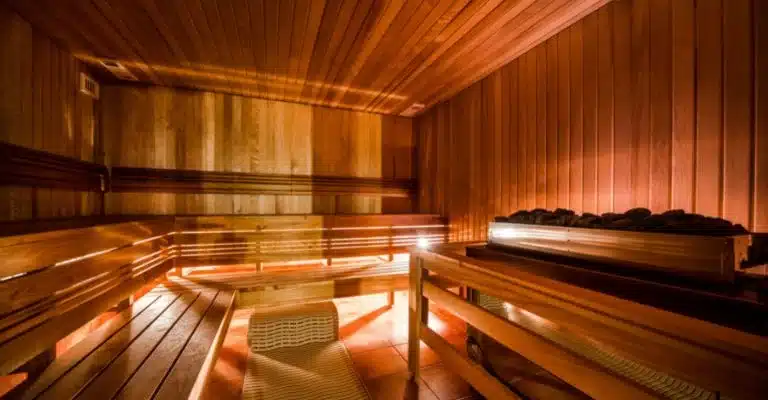The Evolution of Hot Tub Design Through the Decades
Explore the transformative journey of hot tub designs from their humble beginnings to today’s intelligent, luxurious outdoor features. Hot Tub Patio presents an engaging infographic that dives into the decades of innovation, style, and technology, making hot tubs a staple of relaxation and outdoor living.
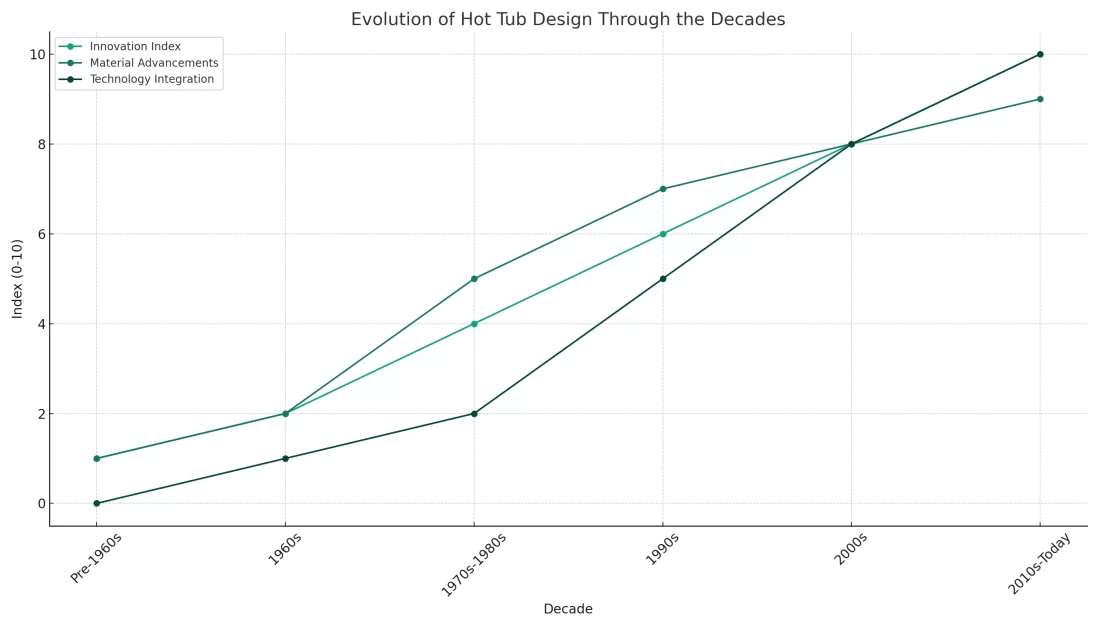
The Early Beginnings (Pre-1960s)
Long before bubbling jets and built-in lighting, the hot tub concept was born from a simple desire for warmth and healing. Our journey begins with two distinct paths:
Nature’s Embrace:
- Natural Hot Springs: Imagine ancient civilizations gathering around naturally heated pools drawn by the geothermal wonders of the Earth. From Yellowstone National Park to Japan’s onsen culture, these naturally occurring sanctuaries provided solace and therapeutic benefits for centuries.
- Indigenous Practices: Native American tribes across North America utilized heated stones and pits to create rudimentary hot tubs for medicinal purposes and social gatherings.
Early Innovations:
- Wood-Fired Tubs: The first manufactured hot tubs emerged as ingenuity took hold. Crafted from wood, these often barrel-shaped tubs were heated by external wood-fired stoves, requiring manual tending and offering a rustic charm.
- Metal Tubs: In the late 19th century, galvanized metal tubs offered a more durable alternative, paving the way for broader accessibility and portability.
These early forms laid the foundation, showcasing the enduring appeal of hot tubs for relaxation and social connection.
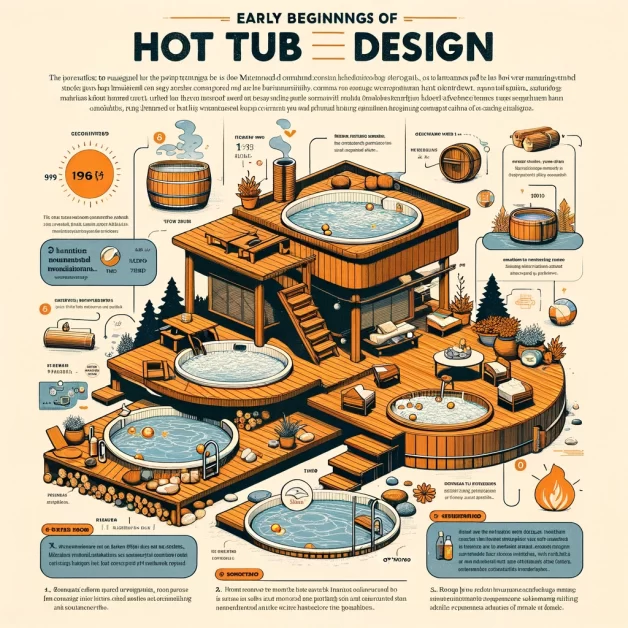
The 1960s: Birth of the Modern Hot Tub
The 1960s marked a turning point in hot tub history with the arrival of the first commercially available models. These pioneering tubs brought the spa experience closer to home, igniting a new era of backyard enjoyment.
Key Features:
- Wood Construction: Building upon the tradition of wooden tubs, early commercial models were mainly crafted from redwood or cedar, exuding a rustic and natural aesthetic.
- Simple Shapes: Round or octagonal designs dominated, offering timeless elegance and maximizing space for soaking.
- Jet Propulsion: Although basic compared to modern systems, the introduction of jet pumps added a touch of luxury with massaging bubbles.
- Electric Heating: Replacing the wood-fired approach, electric heating elements provided a more convenient and consistent way to warm the water.
These early hot tubs weren’t just functional; they became symbols of a laid-back lifestyle, often featured in movies and magazines, fueling their growing popularity. While these 1960s models seem primitive compared to today’s high-tech offerings, they paved the way for the evolution of hot tubs into the backyard havens we know and love today.
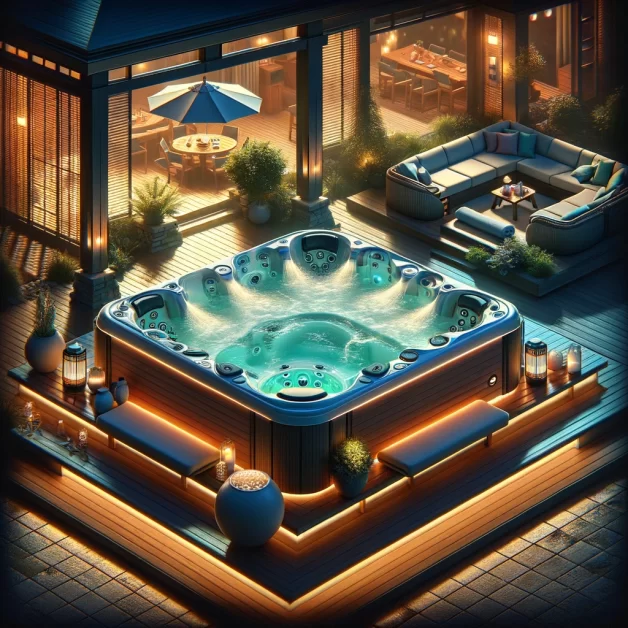
The 1970s and 1980s: Innovation and Expansion
This era witnessed a significant material shift from wood to more durable fiberglass and acrylic, introducing the first jets, filters, and heaters. These innovations made hot tubs more accessible, customizable, and comfortable, setting the stage for the luxurious models.
The 1970s and 1980s were a period of significant innovation and expansion for hot tubs. Let’s delve deeper into the fundamental changes:
Material Revolution:
- Fiberglass & Acrylic: Wood, while charming, had its limitations regarding weather resistance and maintenance. This era saw the introduction of fiberglass and acrylic, which offered increased durability, smoother surfaces, and easier cleaning. These materials paved the way for more modern designs and opened the market to a broader audience.
Feature Frenzy:
- Jets and Pumps: From basic bubbling to targeted massage, the 1970s saw the introduction of adjustable jets and more powerful pumps, elevating the hot tub experience from simple soaking to a therapeutic sensation.
- Filtration Systems: Maintaining clean water became more accessible with the introduction of built-in filtration systems, ensuring a more hygienic and enjoyable soak.
- Energy-Efficient Heaters: As technology advanced, electric heaters became more efficient, reducing energy consumption and making hot tub ownership more cost-effective.
Expanding Horizons:
- Portable Models: The 1980s witnessed the rise of portable hot tubs, making them more accessible for smaller backyards and apartments, further fueling their popularity.
- Customization Options: Beyond the basic round shape, manufacturers began offering a more comprehensive range of shapes and sizes, catering to diverse needs and preferences.
Setting the Stage:
These advancements in the 1970s and 1980s transformed hot tubs from rustic indulgences into comfortable, convenient, and customizable backyard luxuries. They laid the foundation for the sophisticated hot tubs we enjoy today, paving the way for even more innovations in the decades.
The 1990s: Luxury and Leisure
The 1990s redefined hot tubs as symbols of luxury, incorporating multiple jets, diverse seating arrangements, and mood lighting. Designs became more sophisticated, offering a variety of shapes and sizes to fit any outdoor space or aesthetic preference.
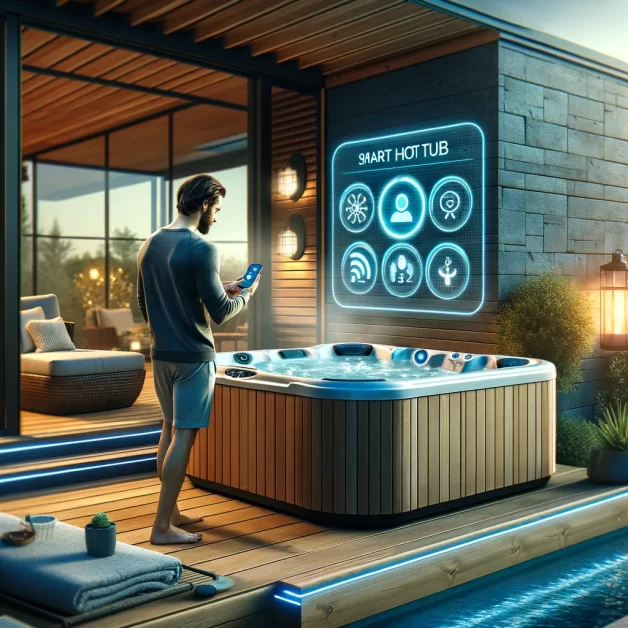
Key Features:
- Hydrotherapy Haven: The 1990s saw jets explode, with targeted massage capabilities and adjustable pressure, focusing on specific muscle groups for a truly therapeutic experience.
- Seating Revolution: Beyond the traditional circular layout, manufacturers introduced diverse seating arrangements, including benches, loungers, and even built-in footrests, catering to individual preferences and group enjoyment.
- Mood Lighting: Setting the ambiance became critical with the introduction of mood lighting, transforming hot tubs into intimate and inviting spaces perfect for relaxation or entertaining.
- Design Refinement: From sleek and modern to rustic and traditional, a more comprehensive range of shapes and sizes emerged, allowing homeowners to match their style and space constraints.
- Material Advancements: While fiberglass and acrylic remained popular, the 1990s also saw the introduction of newer materials like Lucite and gel coat, offering improved durability and aesthetics.
Impact:
These advancements cemented the hot tub as a coveted backyard accessory, attracting a wider audience beyond luxury homeowners. Hot tub ownership became more accessible, increasing popularity in residential settings.
The 2000s: Technological Advancements
The turn of the century brought technological integration into hot tub design, including digital controls and sound systems. Energy efficiency and eco-friendly models also emerged, reflecting a growing environmental consciousness among consumers.
Tech-Savvy Soaking:
- Digital Controls: Intuitive digital control panels replaced analog dials, offering precise temperature control, jet customization, and even pre-programmed massage routines.
- Sound Systems: Built-in sound systems with waterproof speakers transformed hot tubs into entertainment hubs, allowing users to enjoy music or podcasts while soaking.
- Integrated Features: Features like waterfall fountains and chromotherapy lighting added to the sensory experience, creating a truly luxurious and personalized spa-like atmosphere.
Sustainability in Style:
- Energy Efficiency: As environmental awareness grew, manufacturers focused on developing energy-efficient models with improved insulation and heating systems, reducing operating costs and environmental impact.
- Eco-Friendly Materials: Some manufacturers introduced recyclable materials and eco-friendly components, catering to environmentally conscious consumers.
Impact:
These innovations made hot tubs more technologically advanced, user-friendly, and environmentally responsible, appealing to a broader range of consumers who valued both luxury and sustainability.
The 2010s to Today: Smart Hot Tubs and Customization
Recent years have seen the rise of intelligent hot tubs equipped with connectivity for remote monitoring and control, emphasizing convenience and efficiency. The trend towards customization allows these hot tubs to seamlessly integrate into personalized outdoor living spaces, enhancing the overall home leisure experience.
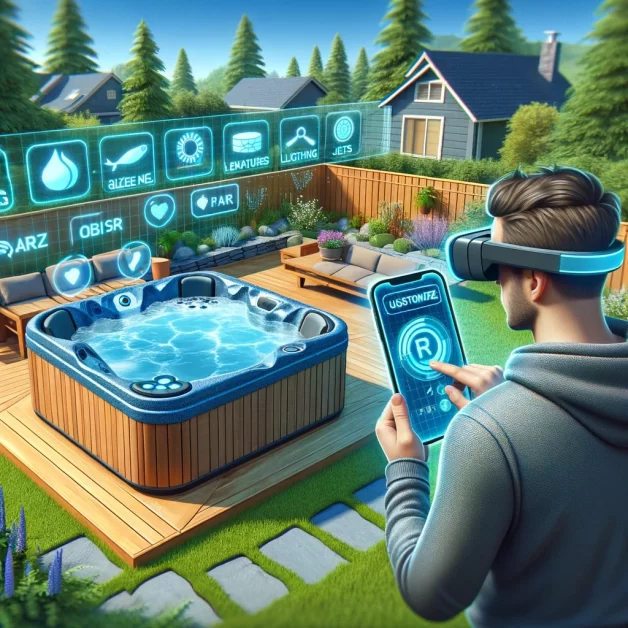
Smart Revolution:
- Smartphone Control: Imagine adjusting the temperature or activating jets from your phone – bright hot tubs integrate with apps, allowing remote monitoring and control for ultimate convenience.
- Integrated Tech: Advanced features like built-in Wi-Fi and voice assistants enhance the experience, enabling music streaming, weather updates, and even personalized light shows.
- Safety and Diagnostics: Smart features also provide real-time monitoring of water quality, filter status, and potential issues, ensuring optimal performance and peace of mind.
Customization Craze:
- Modular Designs: Today’s hot tubs offer interchangeable components like seats, jets, and lighting, allowing individuals to tailor the experience to their needs and preferences.
- Aesthetics for Every Style: From sleek and modern to rustic and natural, various materials, colors, and finishes cater to diverse tastes and outdoor spaces.
- Integrated Accessories: Manufacturers offer a wide range of add-ons, like steps, covers, and even built-in bars, to create a complete and personalized backyard oasis.
Impact:
The combination of intelligent technology and customization options makes hot tubs more than just tubs; they transform into personalized home extensions, seamlessly integrating into outdoor living spaces and catering to individual preferences.
[wps_google_trends query=”Hot tub” geo=”US”]
The Future of Hot Tub Design
Looking ahead, we anticipate further technological, design, and sustainability advancements. Innovations may include augmented reality for virtual customization, advanced filtration systems for reduced water usage, and even more personalized settings for health and relaxation.
Emerging Technologies:
- Augmented Reality (AR): Imagine virtually “trying on” different hot tub configurations, finishes, and lighting options in your backyard before purchasing. AR could revolutionize the customization process.
- Voice-Activated Controls: Beyond smartphone apps, imagine seamlessly controlling every aspect of your hot tub – temperature, jets, lighting, even music – simply by using your voice.
- Biometric Sensors: Hot tubs could integrate sensors that monitor individual health data (heart rate, muscle tension) and automatically adjust settings for a personalized and optimized therapeutic experience.
Focus on Sustainability:
- Advanced Filtration Systems: Closed-loop water filtration systems could drastically reduce water consumption and waste, making hot tubs more eco-friendly.
- Energy-Harvesting Technologies: Imagine solar panels or other renewable energy sources powering your hot tub, minimizing its environmental impact.
- Recycled and Biodegradable Materials: Utilizing sustainable materials in hot tub construction would lower their environmental footprint throughout their lifecycle.
Personalized Wellness:
- AI-Powered Wellness Programs: Hot tubs could integrate with AI-powered programs that personalize water temperature, massage patterns, and lighting based on individual user profiles and wellness goals.
- Integrated Aromatherapy: Imagine built-in diffusers releasing customized essential oil blends to enhance relaxation, muscle recovery, or sleep quality.
- Immersive Soundscapes: Advanced sound systems could create personalized, immersive soundscapes that complement and enhance the therapeutic experience.
The Future of Hot Tub Design
Looking ahead, we anticipate further technological, design, and sustainability advancements. Innovations may include augmented reality for virtual customization, advanced filtration systems for reduced water usage, and even more personalized settings for health and relaxation.
Conclusion
From simple, wooden tubs to today’s sophisticated, technology-integrated models, hot tub design has evolved remarkably over the decades. Hot Tub Patio remains at the forefront of this evolution, offering the latest hot tub design and outdoor living solutions.
Our commitment to quality, innovation, and customer satisfaction makes us your go-to source for enhancing your outdoor leisure experience.








